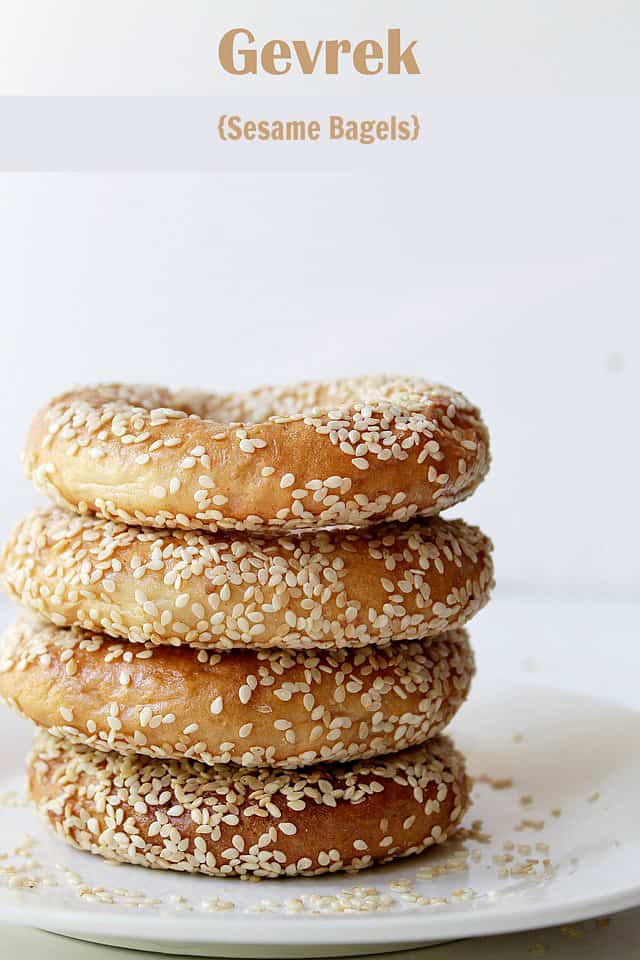Sesame Bagels – Gevrek, similar to a bagel, or even a soft pretzel, is a chewy, yet soft bread-snack, shaped into a ring, dipped in honey and water, topped with sesame seeds and baked.
Hey! Happy Monday!
Now, now… Friday will be here soon. Let’s enjoy the week, and start it with a Gevrek! I should probably teach you how to pronounce that. Okay… hmmmm… let’s try gjev-wreck. I think.
I run, what one might call, an eclectic kitchen. Multi-ethnic, if you will.
I serve Asian one day and show up with some Cashew Chicken Meatballs, then Italian the next with some Baked Eggplant Penne Pasta, and other times I serve my own, Macedonian.
Now, before I go to claim Gevrek as solely Macedonian, allow me to tell you that it is not. It belongs to everyone on the Balkans, and beyond, but as far as I know, they belong mostly to the Turks. It’s their thing, but we all have our different spin on it.
The difference in a Macedonian Gevrek (Bagel) is that, unlike the others, we don’t dip it in molasses; we use honey. Also, our Gevrek is more like a soft pretzel. It’s soft, and nowhere near as dense as the Turkish one, which might even be mistaken for a bagel. To add, Turks like to enjoy their Gevrek, or Simit, with jam and tea. Macedonians, on the other hand, reach for some plain yogurt and dip it, just as you would dip a soft pretzel in cheese.
This little treat takes a bit of time to make. And it wants love. You can’t rush it. You need to love it, respect it, and take your time with it. I have made these on multiple occasions, and I’m still learning. I know, it’s in the technique. I get it.
I like our little bloggy system here, don’t you? I get to cook for you, teach you a thing or two about different cuisines, take photos of it, and you get to read and drool! I really hope I’ve made you drool at least once during your stay(s) here. 😉
If you have a free moment, or an entire morning, make these. You’ll kiss yourself for it.
ENJOY!

Sesame Bagels {Gevrek}
Ingredients
- 3½ teaspoons active dry yeast
- Pinch of sugar
- 1/4 cup warm water
- 4 cups unbleached all-purpose flour
- 1¼ teaspoon salt
- 1 cup lukewarm water
- 1 cup honey
- 1 cup water
- 2 cups sesame seeds
Instructions
- In a large mixing bowl, stir together yeast, sugar and warm water; let stand 10 minutes, or until frothy.
- Add flour, salt, and 1 cup water to yeast mixture.
- Mix until combined. You may need to mix with your hands.
- Transfer to a lightly floured surface and knead for 15 minutes by hand, or 10 minutes by heavy-duty mixer, until the dough is very smooth.
- Lightly oil a large bowl, place the dough in the bowl and turn to coat with oil.
- Cover with plastic wrap and kitchen towel; let stand for 2 hours.
- Place dough on a lightly floured work surface and knead it for 5 minutes.
- Roll the dough into a log and cut it into equal pieces.
- Form each piece into a ball and let rest under a towel for 30 minutes.
- Roll each ball into a 10-inch long rope.
- Form the rope into a ring, pressing the overlapping ends together to seal.
- Place on a greased baking sheet and let rest 1 hour.
- Preheat oven to 450.
- In a medium size mixing bowl whisk together honey and 1 cup of water.
- Put the sesame seeds on a flat plate.
- Dip each ring of Gevrek in honey-water first, then in the sesame seeds, completely coating the Gevrek with the sesame seeds on all sides.
- Continue with the rest of the dough and transfer them all back to the baking sheet; let rest 30 minutes.
- Take each ring and rotate it gently through your hands, enlarging it into about a 6-inch circle.
- Place the rings back on the baking sheet and let rest for 15 minutes.
- Bake for 15 to 20 minutes, or until golden brown.
- Let rest for 5 minutes.
- Serve plain or with a side of yogurt.
Notes
Nutrition
Nutritional info is an estimate and provided as courtesy. Values may vary according to the ingredients and tools used. Please use your preferred nutritional calculator for more detailed info.





